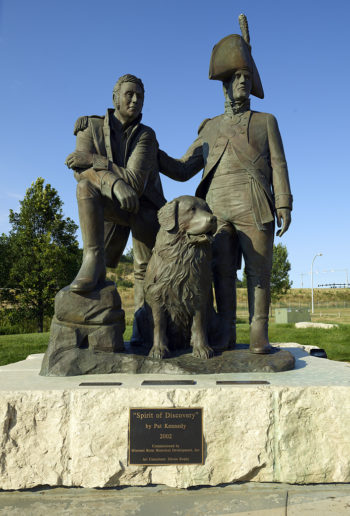 By Michael Swanger
By Michael Swanger
When Meriwether Lewis, William Clark and their Corps of Discovery set out to explore and document the American West from May 1804 to September 1806, they spent a total of 39 days along the western edge of what is now Iowa while traveling the Missouri River.
It would have had to have been an incredible sight for them to behold … the velocity of the river, which Lewis described as “perhaps unequaled by any on earth,” the surrounding bluffs, the stands of cottonwoods, willows, elms, hickories, walnuts and oaks in the bottomlands and the spacious views offered by the plains.
Today, 215 years after having launched their courageous journey, resources abound regarding the Lewis and Clark Expedition, including what they discovered, who they encountered and the hardships they endured. From popular books and scholarly articles, to museums, monuments and parks along the Lewis and Clark National Historic Trail, there is no shortage of information and experiences to help us better understand the magnitude and details of their expedition.

Statue of the American explorers Meriwether Lewis (in hat) and William Clark outside the Lewis & Clark Interpretive Center in Sioux City, Iowa.
While sites along the Lewis and Clark National Historic Trail in Iowa offer breathtaking views, few resources capture the imagination and pioneer spirit quite like the journals written by Lewis and Clark and four of their enlisted men who provided vivid descriptions and drawings of American Indians, the land and their discoveries of new species of flora and fauna. Their efforts with ink and paper not only brought the story of their expedition to life, but provided an early glimpse of what a portion of our state looked like when it was part of the 828,000 square miles of the Louisiana Purchase, about 40 years before statehood.
Their journals have been reproduced and interpreted in volumes of books, but if you have wondered what daily life was like for the approximately 50 men of the Corps of Discovery, Gary E. Moulton’s new book “The Lewis and Clark Expedition Day by Day” is a good place to start. Of particular interest to Iowa history buffs might be the daily accounts painstakingly edited by Moulton of the expedition’s 34-day journey along the western edge of our state from July 18 to Aug. 21, 1804, as well as its last five days here, Sept. 4-9, 1806, during their return trip home.
A number of significant events occurred as the expedition ascended the Missouri River in 1804 between what is now Iowa and Nebraska. Among them was their first encounter with American Indians, specifically six Oto and Missouria chiefs on Aug. 2, which led to a meeting the next day in which they “passed a ceremonial pipe, demonstrated their weapons, and gave gifts to Indian dignitaries.” By all accounts, it was deemed a success.
Another important event was the death of U.S. Army Sgt. Charles Floyd on Aug. 20. He died, apparently, of a ruptured appendix. It would be the expedition’s only casualty. His peers buried him with full military honors on a bluff and commemorated him by naming Floyd’s River in his honor. They also visited his grave during their return home in 1806. Today, the Sergeant Floyd Monument in Sioux City is designated as a National Historic Landmark.
The expedition also experienced the desertion and capture of U.S. Army Pvt. Moses B. Reed in August 1804. He would be courtmartialed for desertion on Aug. 18, which also was the 30th birthday for Lewis.
Along the way, they also established Camp White Catfish near the Mills-Pottawattamie county line. It is there, perhaps, that the beauty of Iowa is best documented by the expedition. After climbing the bluffs along the river and seeing the surrounding prairie, one of the enlisted men described it as the “prittyset place for a Town” that he ever saw.
Their journals are timeless, important early explorations of our state to be enjoyed by generations of Iowans. Take the journey.
TO READ MORE FASCINATING STORIES ABOUT IOWA HISTORY, subscribe to Iowa History Journal. You can also purchase back issues at the store.
